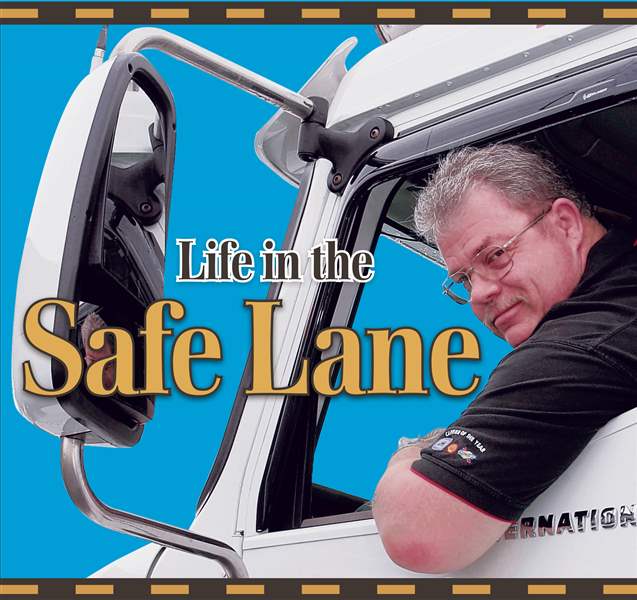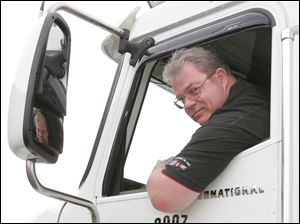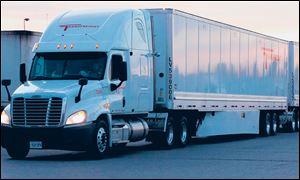
ENTERTAINMENT
Semi truck expert Ron Hawkins, Jr. shares tips for driving on the highways
4/9/2014
Ron Hawkins, Jr., a 1976 alumnus of Start High School, says drivers need to give large vehicles plenty of room on the highway.
THE BLADE PHOTO ILLUSTRATION
Buy This Image

Ron Hawkins, Jr., a 1976 alumnus of Start High School, says drivers need to give large vehicles plenty of room on the highway.
Ron Hawkins, Jr., wants to save your life, especially if you’re sharing the road with a semi truck.
Say you’re driving and you need to get around the tractor-trailer in front of you. You decide to use the right lane to pass the semi.
Bad idea, Mr. Hawkins says. Why? Because the truck driver cannot see you.
“Never pass a truck on the right side because my blind spot is four or five lanes wide,” on that side of the truck, he said. “If you cannot see the driver’s face in the mirror, he cannot see you at all.”
That’s why he urges passenger cars to “Always pass on the left. The blind spot is smaller.”
Mr. Hawkins should know. He’s been driving a semi for 30 years, and not once has he had an accident. In March his company, K-Limited Carrier LTD of Toledo, honored him for having such a stellar record. He has driven more than 2 million miles, and in 2007 he was named the state’s professional driver.
In 2009 and 2010 he was an American road team captain, which featured his driving skills. Mr. Hawkins is currently a finalist for the National Tank Truck Usher Driver of the Year award.
He enjoys talking about his clean record, and he makes it clear that he wants other motorists to be safe around tractor-trailers. In 2012, there were 1,130 traffic fatalities on Ohio highways. The Federal Motor Carrier Safety Administration reports that slightly more than a third of all highway fatalities involving trucks occur within a truck’s blind spots.
Mr. Hawkins talked more about the blind spots around semis after the Toledo Trucking Association’s annual luncheon at the Inverness Club. The highlight of the event was the awarding of a $5,000 scholarship to Christina Koepke, 21, of Temperance. The University of Toledo student has a triple major: supply chain management, human resources management, and marketing.

Semis need a significant safety cushion so they can stop safely, according to Mr. Hawkins, who has driven semis for 30 years.
Mr. Hawkins, a 1976 graduate of Toledo’s Start High School, said, “The main thing about driving around large vehicles is that you want to give them plenty room. I cannot see you if you are within 25 car lengths behind. I can take a full length school bus, fold the mirrors in, and park it behind the truck, and you would never see it in my mirrors.”
Because of their size, semis need a significant safety cushion so they can stop safely, Hawkins explains. When the tank on the 55-foot to 60-foot long semi he drives is full, it takes the length of “one football field and both end zones to stop.”
Stopping distance can also be impacted by the cargo being carried. Smooth bore tankers (ones that don’t use baffles to compartmentalize their cargo) have nothing inside to slow down the flow of the liquid. Therefore, forward and back surge is very strong. Smooth bore tanks are usually those that transport food products such as milk. Sanitation regulations rule out the use of baffles because of the difficulty in cleaning the inside of the tank. Corrosive liquids are also routinely transported in smooth bore tanks.
He also warns passenger car drivers not to linger while passing big trucks. And once by a semi, Mr. Hawkins said, “don’t get back into the lane until you can see both my headlights in your rear view mirror.”
The American Trucking Association estimate there are 15 million trucks on U.S. roads and highways, 2.3 million of which are semis.
Truck drivers need a significant safety cushion so they can stop safely, Hawkins explains. When the tank on the 55-foot to 60-foot long semi he drives is full, it takes the length of “one football field and both end zones to stop.”
Mr. Hawkins, who lives in Perrysburg, has noticed some changes during his three decades behind the wheel of a rig: “Traffic is getting heavier and there’s not as much courtesy,” he said.
And sitting high in the cabin, truck drivers see quite easily into passenger vehicles. “I’ve seen guys shaving and people reading the newspaper,” he said -- and yes, he means while they were driving.
“Everybody” is distracted, he laments, whether it’s young people talking to their friends, a parent trying to sooth a crying baby in the back seat, someone eating, or putting on makeup.
The No. 1 offense? That’s easy: passenger car motorists using hand-held cell phones to talk and text. And if you’re curious, Mr. Hawkins said, “It’s illegal for truckers to use hand-held cell phones.”